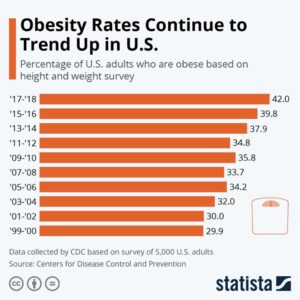 Did you know that there are now more dangerously overweight than malnourished people in the world? With over one third of their population classified as obese, the United States is one of the countries most affected. It’s easy to jump to conclusions and dismiss the ‘obesity epidemic’ as a symptom of ever-growing laziness in the Western world. Instead, the tripling of the obesity rate in the U.S. over the last 50 years can mostly be attributed to obesogenic environments. You’re asking yourself what that is?
Did you know that there are now more dangerously overweight than malnourished people in the world? With over one third of their population classified as obese, the United States is one of the countries most affected. It’s easy to jump to conclusions and dismiss the ‘obesity epidemic’ as a symptom of ever-growing laziness in the Western world. Instead, the tripling of the obesity rate in the U.S. over the last 50 years can mostly be attributed to obesogenic environments. You’re asking yourself what that is?
An obesogenic environment promotes obesity or encourages behaviors that promote excessive weight gain. Such an environment could manifest itself in ridiculously large buckets of popcorn and cups of soft drinks at a cinema. It can be recognized in the technology designed for capturing your attention and keeping you slumped over your screen for hours on end. It becomes apparent when taking your bike or walking is so dangerous that you would rather take your car to the supermarket down the street.
Adhering to the motto “get them early,” large fast-food companies play a major role in contributing to an obesogenic environment. For instance, Coca-Cola, Burger King, or Kentucky Fried Chicken often place ads for their products during children’s programs, thus targeting the most vulnerable group. Children and teenagers are exposed to more than 40,000 ads per year, many of which advertise fast food and soft drinks. As taste buds develop early on in life, the high-caloric, fatty, or sugary foods will forever influence a child’s taste, even later on as an adult. Of course, this is only one aspect to effect obesity, a condition that is also influenced by genetic and psychological psychological factors.
Once you are in this obesogenic environment – an environment that promotes excessive weight gain – the question suddenly arises, “How can anyone not become overweight?” When your environment constantly tells you to eat more, to drink more, and to move around less, it comes as no surprise that roughly 110 million people in the U.S. suffer from obesity. That an estimated 170–260 billion dollars of medical costs spent each year are related to obesity. That 10% of annual deaths can be attributed to obesity.
Obesity is not due to personal failure but an inevitable result of U.S. culture, a culture that is rapidly spreading to more and more countries all over the world. Recognizing in what ways a certain environment contributes to obesity is essential for designing a world that’s no longer obesogenic but instead promotes healthy diets and physical activity – a world that will help people escape the endless cycle of sit, drink, eat, repeat.
6,023 Total Views, 10 Views Today






